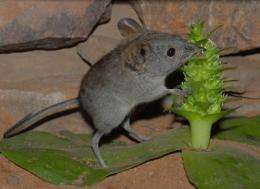An elephant shrew licks nectar with its tongue and touches the pollen sacs. Credit: Wester/Naturwissenschaften
Long-nosed Cape rock elephant-shrews are fond of sticky treats, according to Dr. Petra Wester from the University of Stellenbosch in South Africa. Her investigations show for the first time that the elephant-shrew, Elephantulus edwardii, licks the nectar of the flowers and pollinates the Pagoda lily. Her results are published in Springer's journal, Naturwissenschaften – The Science of Nature.
Dr. Wester studied the behavior of the animals in the northern Cederberg area of South Africa, where Pagoda lily plants, Whiteheadia bifolia (Hyacinthaceae), are found in shady rock crevices and cavities. Over four nights, she placed mammal traps with baits – a mixture of peanut butter and rolled oats – near the lily plants. The next day, Dr. Wester collected the faeces of the animals from the traps. Two elephant-shrews were captured and released into glass terraria containing flowering lily plants, where Dr. Wester observed their foraging behavior.
The captive elephant-shrews visited the flowers more than 50 times over four days, moving from one flower cluster to another. With their long, flexible noses they went between the stamens and licked the nectar between the ovary and the stamens with their long, slender tongues. In the process, they touched the pollen-sacs and their long nose got dusted with pollen. The animals also touched the stigmas.
The elephant-shrews indulged in the nectar without feeding on pollen directly or eating, damaging or destroying the flowers. Interestingly, the animals preferred the nectar over the other food – peanut butter with rolled oats and apples – and over water. Dr. Wester also found that the faecal samples of the elephant-shrews contained pollen from the Pagoda lily, the likely result of fur grooming after flower visits, rather than actual feeding on pollen.
Elephant-shrews, together with rodents, primates and marsupials, are part of a rather unusual group of pollinating animals that are known as 'non-flying mammals' to differentiate them from the more common bats. Elephant-shrews look similar to mice, except for their long nose, but are not related to rodents. They belong to the order Macroscelidea, which includes aardvarks, tenrecs, golden moles, hyracoids, sirenians and elephants.
Dr. Wester concludes: "Data on elephant-shrews as pollinators are extremely scarce. This study is the first to clearly show that Elephantulus edwardii visits flowers for nectar and as a consequence also pollinates them. It is very likely that further species of elephant-shrews might be pollinators."
More information: Wester P (2010). Sticky snack for sengis – The Cape rock elephant-shrew, Elephantulus edwardii (Macroscelidea) as a pollinator of the Pagoda lily, Whiteheadia bifolia (Hyacinthaceae). Naturwissenschaften; DOI:10.1007/s00114-010-0723-6
Provided by Springer



















